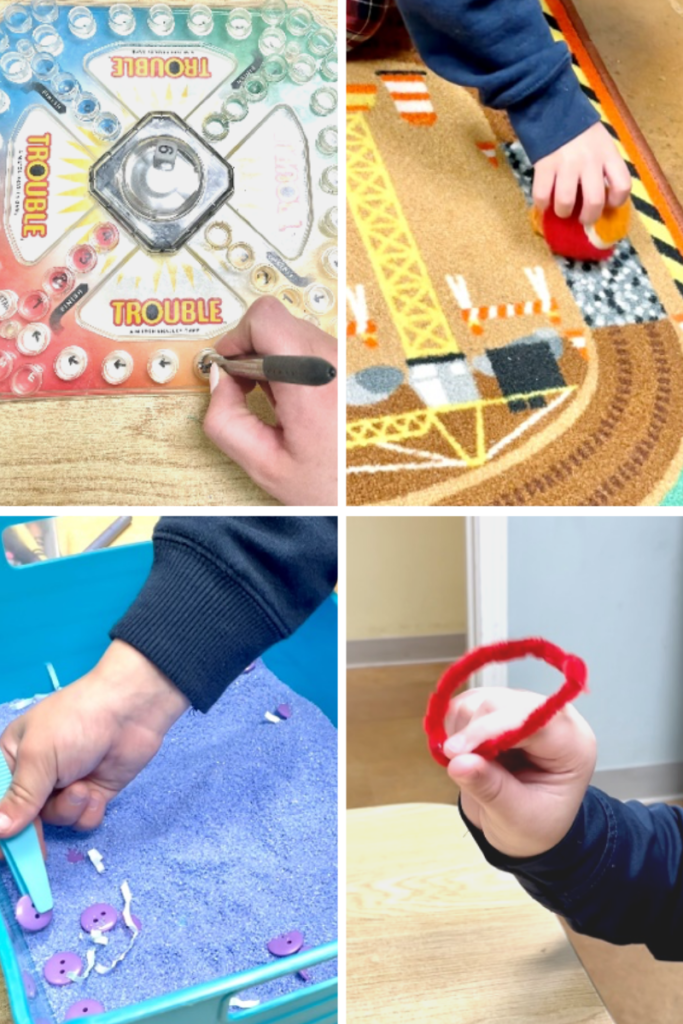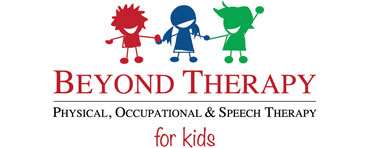With the rise of an emphasis on standardized testing in elementary schools, it’s no surprise that parents and teachers are feeling the pressure to make sure that children are learning to read and write at a very young age. However, is teaching 3 and 4-year-olds how to write letters and memorize sight words really going to benefit these children over time? Let’s explore the right approach to writing including the visual-motor components as well as hand strength and dexterity.
The Right Approach to Writing Letters
Writing letters seems like a simple task, right? You just copy a few lines, and BOOM, there’s your letter. Well, it’s actually not that simple. There are several underlying skills that you must have in order to make this process of writing letters go smoothly.
Visual-Motor Component
This can be a hard concept to understand, so let’s break it down even further. First, there’s vision – your eyes’ ability to see. When we think of vision, we think of ophthalmologists determining if you have 20/20 vision or not, and prescribing glasses or contacts to assist if you have visual deficits. Then there’s visual perception. Visual perception is not what your eyes see, but rather, your brain’s interpretation of what your eyes see. In turn, visual-motor skills are your ability to see something, process what you’re seeing, and give a response. Visual-motor skills are ultimately what enable you to copy letters and words. BUT, these skills take a while to develop. At 3 and 4 years old, our brains are not developed enough for this complex task. Instead of focusing on drawing letters, here are a few other activities that will help develop visual motor skills:
Complete puzzles together
- Start with wooden puzzles, matching pieces to their picture underneath.
- Gradually work up to interlocking puzzles.
- Be sure to talk about matching the colors and lines, as well as looking at the individual pieces and the puzzle as a whole.
- If the puzzles you have are too difficult, work on just a couple of pieces at a time, and cover up the rest of the puzzle so it’s not so overwhelming.
Build with blocks
- See if your child can copy what you build, then try to copy what they build! Start with 3-4 blocks, and work your way up to more complex forms.
When you’re ready to put pencil to paper, practice with your child on copying different lines and shapes. Though it seems rudimentary, it is essential and will help your child in the long run! A quick Internet search of prewriting strokes will give you a good idea of age-appropriate pre-handwriting strokes. For example, at 2 years, a good goal would be to copy a vertical line; at 3 years, a circle; at 4 years, a square.
Hand Strength and Dexterity
Now, let’s talk about the other main component of handwriting: hand strength and dexterity. Again, these skills may sound simple and unimportant, but they play a huge role in success with handwriting down the road. Often kids with good visual perception skills may be able to copy letters, but when it comes time for them to write paragraphs in first and second grade, they become fatigued and handwriting becomes sloppy and illegible. In the point and click, drag and drop, screen time world that we live in, it’s no wonder that these skills are being overlooked. Instead of coloring on paper, kids are able to color on a tablet with their fingers, which does not require the grasp of a crayon or pressure you need to color on paper. It’s much more effortless. Screen time use is at an all-time high, and with the busy lives we live, cleaning up messes from an art project gone rogue is the last thing we want on our plates. But, developing hand strength and dexterity early on will help set up for the right approach to writing. It’s a marathon, not a sprint.
Did you know we can start working on these pre-handwriting/ strength and dexterity skills as early as infancy? Here are a few ways we can do this:
- Lots of tummy time, pushing on open hands. This helps develop stability and strength in the core/ shoulders, which is essential to develop prior to dexterity.
- Despite the CDC’s updated list of milestones, which removed crawling as a milestone, crawling is another important skill that later impacts handwriting! (Make sure to crawl on hands and knees with alternating right and left sides!) This helps develop the arches of your hand and coordinate the left and right sides of your body to work together.
- Reaching and grasping for blocks, rattles, and other toys, gradually working towards grasping smaller items such as puffs or cheerios with fingertips can also help with the development of fine motor skills. Make it harder as your baby gets better at it. One of my favorite tricks is putting cheerios in the divets of Pop Its for my babies to pick out.
If your child is older, and writing seems daunting to them—that’s okay! We still have to address other things before actually putting pencil to paper. Here are some ideas for developing the essential hand strength and dexterity skills needed for success in school. Some of them even use pencil and paper without having to write anything!
- Using one hand, crumble an entire piece of paper into a ball, then uncrumble. Try not to use your body or a table to help you.

- Tear paper into small pieces, then roll them up into balls. Take turns flicking them towards a target. Make sure to keep the ring and pinky finger curled! (Those fingers have to remain against the palm when writing using a mature dynamic tripod grasp).
- Using your thumb, index finger, and middle finger, rotate a pencil in your hand. Try to do it 10x without dropping, then reverse.
- Using a pen upside down, see how fast you can move around a board game (Trouble! Is my personal favorite), clicking the pen on each spot. This will require not only maintenance of grasp, but also requires strength to push down. The “click!” sound gives great feedback.
- Roll a ball on a “road” using only your fingertips of one hand to move the ball. Make sure to keep at least one finger on the ball at all times. As you advance, try it on a vertical surface! (Dry erase markers are great for drawing on mirrors for this activity).
- Grab a ponytail holder (hair tie) and place it on your thumb (like a ring on a pole). Try to maneuver the ponytail from one finger to the next using only that hand.
- Use tweezers, clothespins, or chip clips to grab small manipulatives such as beads or buttons from a container of sand. Make sure to keep the ring and pinky finger curled and only use thumb, index, and middle fingers!
- Play with playdoh or Theraputty! Putty is my personal favorite because you can easily increase resistance by putting it in the fridge to make it colder and harder to manipulate as you get stronger. Here are some ideas for making putty fun:
- Have a “treasure hunt”. Hide beads in there to pick out. Pull, push, and roll putty while you look for them.
- Roll it into a snake. Pinch along the “snake” to give it a mohawk, then push it flat. Put the beads back on top, and pinch putty around it to cover them up. Then, use one hand to gently roll the snake up into a snail!
- Use it to practice cutting with plastic scissors. This takes a lot of hand strength as well as the use of both hands.
- Pop bubble wrap! Try placing it on the table and pushing with an index finger while curling the rest of your fingers, or hold it in your hand to pinch with the thumb, index, and middle fingers.
- Gather your loose change. Pick up coins one by one using fingertips, and slide coins into your palm. Make sure to hold on to coins while you pick up more. Then practice moving them back to your fingertips one at a time (while still maintaining grasp in palm with ring and pinky finger) to place them in a piggy bank.
There are many other ways to help develop fine motor skills that are essential for future handwriting success. This is not an extensive list, but it is a starting point if you are looking to develop visual motor skills, strength, and dexterity. Pinterest has great ideas to work towards these skills as well. However, if you are concerned with your child’s handwriting skills or fine motor development, it is always a good idea to have them screened or evaluated by a pediatric therapist to help determine if intervention would benefit your child.
To find a Beyond Therapy for Kids location near you, visit our website.
Amanda Watkins, MOTR/L attended Mississippi State University for undergrad and went on to get her Masters of Occupational Therapy degree at the University of Mississippi Medical Center, graduating in 2017. She has a passion for providing OT services to children of all ages while supporting their families through education as they navigate the therapy world. Amanda is a native of Madison, MS, and currently lives there with her husband, 2 daughters, and 4 dogs.
